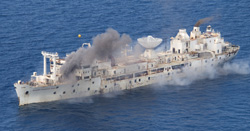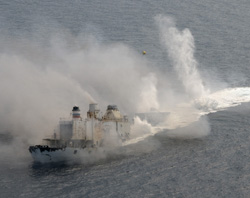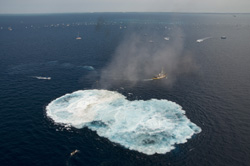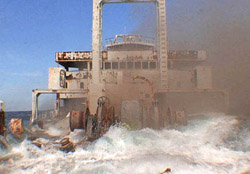VANDENBERG ON THE BOTTOM OFF KEY WEST
KEY WEST, Florida Keys -- The Gen. Hoyt S. Vandenberg sank at approximately 10:24 a.m. Wednesday, May 27, successfully concluding a 13-year-project to convert the decommissioned military missile-tracking ship into a new artificial reef off Key West.
At approximately 10:22 a.m., demolition experts pushed a button that ignited cutting charges strategically positioned in bilge areas below the ship’s waterline.
The Vandenberg disappeared below the waterline just under two minutes later at a location about seven miles south of Key West in the Florida Keys National Marine Sanctuary.
“It was a pretty cool experience,” said Joe Weatherby, who organized Artificial Reefs of the Keys in 1996 and chose the Vandenberg from about 400 decommissioned military ships rusting away in “Ghost Fleets” across the country. “We waited for it a real long time."
The water depth at the sink site is 140 feet, but the 523-foot Vandenberg is so large that its upper superstructure lies only 40 feet below the surface of the ocean.
The ship is the second largest vessel in the world ever purposely sunk to become an artificial reef.
“We think this is really going to be a home run for both our environment and our economy down here,” Weatherby said. “This is good business and at the same time we're taking pressure off our natural coral reefs.”
The sinking also completes the Florida Keys Shipwreck Trek, a series of intentionally sunk vessels that begins off Key Largo with the Spiegel Grove and ends with the Vandenberg.
Seventy percent of the $8.6 million project’s funding resources and some 75,000 man-hours were required to rid the vessel of contaminants, with that work executed in two Norfolk, Va., shipyards.
The ship first saw duty as a U.S. Army troop transport named the General Harry Taylor. It became the Gen. Hoyt S. Vandenberg in 1963 and tracked the U.S. space program’s launches off Cape Canaveral. It also served in the Pacific monitoring U.S. defense missile test launches and eavesdropped on Russian missile launches during the Cold War. Port Canaveral, Fla., was the Vandenberg’s last active duty home port beginning in 1976.
The Vandenberg was formally retired in 1983 and was transferred to the James River Naval Reserve Fleet. But, according to Patrick J. Utecht, who managed the ship’s electronic systems, a team of six technicians would visit Vandenberg every six months to power up all shipboard electronics and make any necessary repairs. Despite the state of readiness, the ship was never used again and in 1993, was formally struck from the naval register and transferred to the Maritime Administration.
The ship received its most public exposure when cast as a Russian science ship in "Virus," a 1999 motion picture starring Jamie Lee Curtis, William Baldwin and Donald Sutherland.
The Vandenberg sinking project has been funded by Monroe County, the Florida Governor’s Office of Tourism, Trade and Economic Development; City of Key West, U.S. Maritime Administration, Florida Fish and Wildlife Conservation Commission, Florida Keys & Key West tourism council, the National Oceanic and Atmospheric Administration as well as industry and private donations. Banks that provided loans include First State Bank of the Florida Keys, BB&T and Orion.

The Gen. Hoyt S. Vandenberg was successfully sunk Wednesday morning about seven miles south of Key West in the Florida Keys National Marine Sanctuary. (All aerial photos by Andy Newman/Florida Keys News Bureau)

At approximately 10:22 a.m., demolition experts pushed a button that ignited cutting charges, and the Vandenberg began its historic descent to the ocean floor.

Just bubbles remained after the Vandenberg sank Wednesday morning, going down in about 140 feet of water. The ship is so large that its its upper superstructure lies only 40 feet below the surface.

A remote onboard camera records the sinking of the Vandenberg. Photo by Steve Panariello and Andy Newman

Joe Weatherby celebrates a successful sinking. Photo by David Sirak

